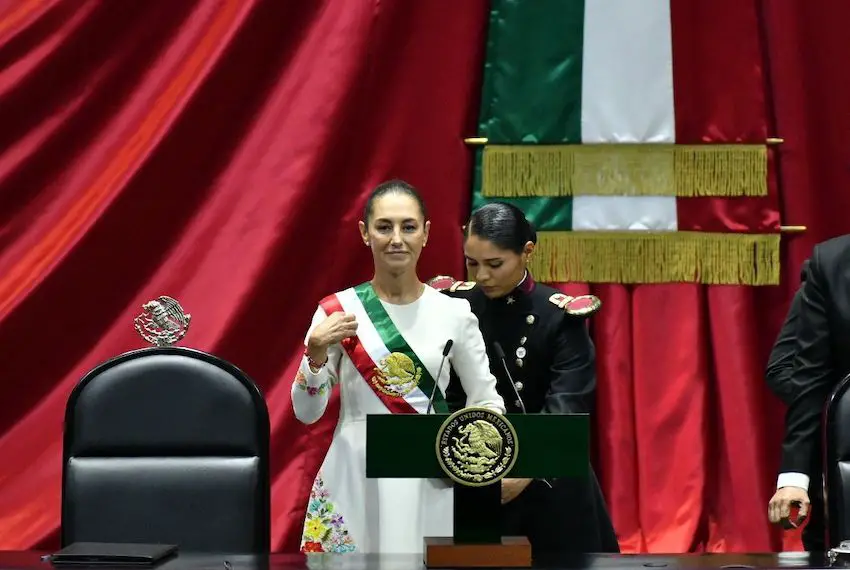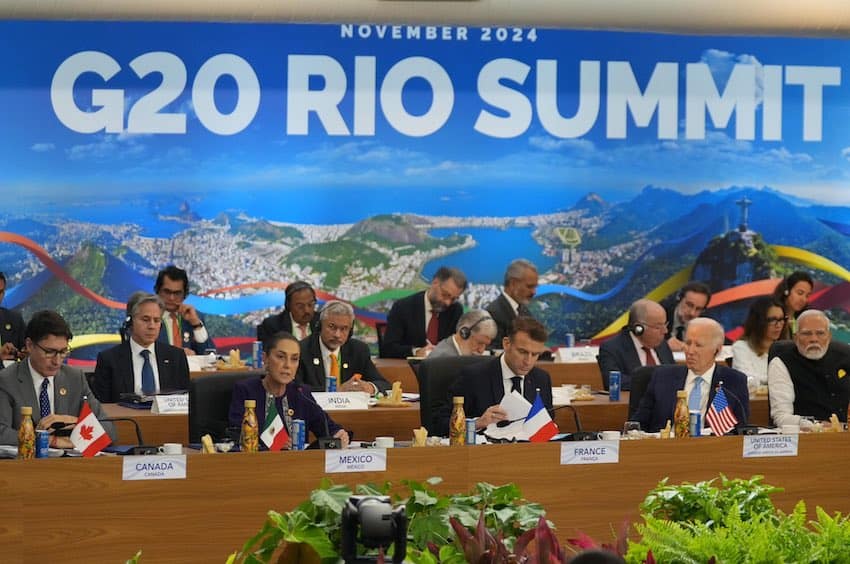With her right arm stretched out in front of her, she pledges to govern in accordance with the Mexican Constitution. The green, white and red presidential sash, adorned with the coat and arms of Mexico, is placed over the chest of a woman for the first time ever. A chant of ¡presidenta, presidenta! rings out in the San Lázaro Legislative Place in Mexico City.
“On June 2 of this year, the people of Mexico, democratically and peacefully, said loud and clear: ‘It’s time for transformation and it’s time for women,'” says the 66th president of Mexico.

All this happened on Oct. 1, 2024.
That’s right. One year has now passed since Claudia Sheinbaum Pardo was sworn in as the first female president of Mexico, marking the commencement of what Sheinbaum calls the “second story” of the fourth transformation of Mexico, a political project initiated by her predecessor and political mentor Andrés Manuel López Obrador (AMLO).
To mark the occasion, Mexico News Daily is publishing a series of articles about Sheinbaum and her first year in office. Among them is a two-part overview of the first year of Sheinbaum’s presidency — 12 months of the first Mexican administration to be led by a woman in 12 numbers.
This is part 1. Part 2 will be published tomorrow, Oct. 2.
3
This is the number of new welfare programs the Sheinbaum administration has introduced.
The federal government has maintained all the welfare programs created by the López Obrador administration, including the Youths Building the Future apprenticeship scheme and the Sowing Life tree-planting employment initiative. Furthermore, it has added:
- A “well-being” pension program (Pensión Mujeres Bienestar) for women aged 60-64. (3,000 pesos every two months)
- An education scholarship scheme (Beca Rita Cetina) for public school students.
- A health care scheme (Salud Casa por Casa) in which doctors, nurses and other health workers visit the homes of seniors and people with disabilities to conduct health checks.
It is difficult to overstate the importance of the government’s welfare programs, both in terms of the monetary commitment to them and the impact they have, and have had, on people’s lives.
Sheinbaum said in her Sept. 1 state of the nation address that the government is allocating 850 billion pesos (US $46.4 billion) to welfare programs in 2025 alone, and highlighted that 32 million families benefit from them. In August, she said that the programs and the increases to the minimum wage in recent years were the main reasons why more than 13 million Mexicans were lifted out of poverty between 2018 and 2024.
Welfare programs have also been a crucial driver of the widespread support for the president and the ruling Morena party, especially in poor southern states such as Chiapas, Oaxaca and Guerrero.
Sheinbaum, like her predecessor, is well aware of this. Adding new welfare programs allows the president to consolidate support among her base, and put her own stamp on the national social agenda.
What they’re saying
The Economist:
“The lack of health-care coverage is not the only way in which the very poorest are worse off under Morena. Thanks to the new universality of handouts, they also get a smaller share of public resources than they used to.”
Welfare Minister Ariadna Montiel Reyes:
“13.4 million people have exited poverty; Mexican humanism is our roadmap. In the second story of the Fourth Transformation, under the leadership of our president Claudia Sheinbaum, we continue implementing and expanding the welfare programs that today are rights of the people of Mexico.”
5
This is the number of foreign countries Sheinbaum visited during the first year of her presidency.
Sheinbaum completed four international trips during her first year as president, visiting five countries: Panama, Brazil, Honduras, Canada and Guatemala.
By contrast, AMLO didn’t leave Mexico during the first year of his presidency, and limited his subsequent international travel to one or two trips per year.
Sheinbaum traveled to Rio de Janeiro last November for the G20 Leaders’ Summit, stopping off on her way to Brazil at the Tocumen International Airport in Panama, where she met the Central American nation’s foreign minister.
In April, she called for “greater regional economic integration” during a speech at the summit of the Community of Latin American and Caribbean States (CELAC) in Tegucigalpa, Honduras, while in June she attended the G7 Summit in Canada, where she also held bilateral talks with several leaders.
In August, Sheinbaum crossed Mexico’s southern border to travel to Flores, Guatemala, where she met with Guatemalan President Bernardo Arévalo. Subsequently, with Arévalo and Belizean Prime Minister Johnny Briceño, she unveiled an agreement creating an international area called the Great Maya Forest Biocultural Corridor.
The president’s international travel during her first year in office shows she is more willing than her predecessor to represent Mexico on the world stage and engage with different countries around the world.
In Rio, she proposed an ambitious global reforestation program and met one-on-one with some of the world’s most powerful leaders, including then U.S. president Joe Biden and Chinese President Xi Jinping.

In Canada, she declared that “economic well-being and cooperation for development are acts of shared responsibility of all nations,” and — amid an immigration crackdown in the United States — spoke out in defense of the “hardworking and honest” Mexicans in U.S.
She traveled to Brazil and Canada in economy class on commercial airlines, a move that underscored her government’s commitment to austerity.
As president, Sheinbaum has not yet traveled to the United States or met face-to-face with U.S. President Donald Trump. But a trip to Washington D.C., and a one-on-one meeting with Trump, could be in the cards in 2026.
What they’re saying
The Wilson Center:
“[Sheinbaum’s] participation in the G20 summit represents Mexico’s reengagement with major international forums after years of withdrawal under former President López Obrador.”
Raymundo Rivas Palacio, journalist:
“Why did President Claudia Sheinbaum fly to Canada on a commercial airline when she uses Mexican Air Force planes in her flights in Mexico? The simplicity is a mask that hides her propaganda.”
7
This is the number of autonomous government agencies that were disbanded as a result of a constitutional reform approved by Congress late last year.
The constitutional reform that paved the way for the disbandment of seven autonomous government agencies was one of the most controversial legislative moves during Sheinbaum’s first year in office.
The National Institute for Transparency, Access to Information and the Protection of Personal Data (INAI), the Federal Economic Competition Commission (Cofece) and the National Council for the Evaluation of Social Development Policy (Coneval) were among the agencies that were eliminated, their functions absorbed into other government departments.
Sheinbaum defended the disbandment of the agencies, touting the move as a cost-saving measure that would also reduce corruption.
However, critics claimed that the motivation for the elimination of the agencies — an initiative submitted to Congress by AMLO — would eliminate important counterweights to government power and represent a backward step for democracy. The reform was seen by many as an attempt to concentrate power in the executive branch of government.
Sheinbaum, unsurprisingly, has denied that the aim of the reform is to increase her own power and discretion.
What they’re saying
Senator Alejandro Moreno, national president of the Institutional Revolutionary Party:
“The elimination of these autonomous bodies represents a direct attack against the rights of Mexicans and against democracy itself.”
Morena Deputy Arturo Ávila:
“There was a lot of duplicity, opacity and even cases of corruption within these autonomous bodies. … In addition to being a very onerous expense for the people, they became white elephants.”
9
This is the number of justices on the bench of the Supreme Court after Mexico held its first-ever judicial elections in June.
Another highly controversial reform, the judicial reform, was approved by Congress just before Sheinbaum took office, but the impact of the constitutional amendment will be felt during this term of government.
The reform enabled Mexico’s first ever judicial elections to be held last June, and the victorious candidates are now serving on the nation’s courts.
Among them are nine Supreme Court justices, who assumed their positions on Sept. 1. All of them are affiliated with, seen as sympathetic to, or were at least tacitly supported by the ruling Morena party.
The popular election of judges, from Supreme Court justices to local judges, is a landmark in Mexico’s judicial history. A second round of judicial elections is scheduled to take place in 2027. The impact of the first round of elections — essentially whether Mexico’s judiciary is changed for better or for worse — will be something to watch closely during Sheinbaum’s second year in office.
The president has staunchly defended the reform put forward by her predecessor, arguing that judicial elections were needed to renew a judiciary plagued by corruption and other ills.
Critics of the reform argued that the election of judges, at a time when Sheinbaum and the ruling Morena party is extremely popular, would result in the nation’s courts being stacked with government sympathizers, thus eliminating a vital check on executive and legislative power. The future rulings of Mexico’s judges and justices, especially in cases involving government policies and projects, could reveal whether that argument is substantiated or not.
What they’re saying
Norma Piña, Supreme Court justice from 2015-25, chief justice from 2023-25:
“The demolition of the judiciary … is not the way to build the peace, justice and reparation Mexico so desperately needs.”
Felipe Calderón, president of Mexico from 2006 to 2012:
“The judicial branch is [now] in the hands of militants and supporters of Morena. Some of them [the judges] were lawyers of narco-traffickers, others are people without experience.”
President Sheinbaum:
“Our adversaries say there is authoritarianism but how [can there be] if it is the people who decide [who the judges are]? Democracy is government of the people by the people for the people. And now the judicial power will serve the people of Mexico and the nation as it should have always done.”
12
This is the percentage by which Mexico’s minimum wage increased in 2025.
Supporting a healthy annual increase to the minimum wage is a clear way that governments and presidents can show they are on the side of workers and not subservient to the interests of the top end of town.
The minimum wage almost tripled during AMLO’s six-year term, and continued its upward trajectory with a 12% increase that took effect on Jan. 1, 2025.
Shortly after she was sworn in, Sheinbaum said she would like to see 12% annual increases to the minimum wage throughout her presidency.
“We’ll be working toward that, seeking a consensus so that it can be a reality,” she said last October.
Supporting double-digit annual increases to the minimum wage, along with an outlay of close to 1 trillion pesos on welfare, adds credence to the Morena party slogan “For the good of all the poor come first.”
There is no doubt that Mexico’s lowest-paid workers could use some extra money in their pockets.
What they’re saying
President Sheinbaum:
“During the entire neoliberal period, which Mexico lived from 1982 to 2018, job creation was spoken about, the salary didn’t matter. Furthermore, they boasted to the whole world that Mexico had cheap labor — that was the competitiveness of the country. What happened then? Reduction of salaries, the minimum wage didn’t increase.”
The El Economista newspaper (Aug. 20, 2025):
“Reaching a minimum wage of 9,437 pesos in 2026 – and 11,796 pesos in 2030 – seems technically possible and politically viable. The challenge lies in what is not seen in the figure: the impact these adjustments may have on labor costs, inflation, and employment dynamics, especially for small businesses. The goal is set, but the challenge will be to not lose balance along the way.”
25
This is the percentage by which homicides declined in the first 8 months of 2025 compared to last year.
At President Sheinbaum’s morning press conference on Sept. 9, security official Marcela Figueroa presented data that showed that there was an average of 68.4 homicides per day across Mexico in the first eight months of 2025. The figure represents a decrease of 24.7% compared to the average daily murder rate through 2024.
Federal officials, including Sheinbaum, were even more eager to highlight that homicides in August were 32% lower than in September 2024, the final month of AMLO’s six-year term, or sexenio.
Zacatecas, down 83%, leads nationwide reduction in homicides: Tuesday’s mañanera recapped
Sheinbaum asserts that the reduction in homicides achieved during her presidency is proof that her government’s security strategy is working. The government unveiled a new security strategy shortly after it took office last October. It is based on four key pillars:
- Attention to the root causes of crime.
- Consolidation of the National Guard, which is now under military control.
- Strengthening of intelligence and investigation practices.
- Enhanced security coordination between authorities at the three levels of government.
Much of the violent crime in Mexico is linked to organized crime groups, including six cartels that have been designated as foreign terrorist organizations by the United States government.
What they’re saying
Carlos Pérez Ricart, an academic who focuses on arms trafficking, drug policy, and organized crime:
“The reduction in homicides is the best news of the sexenio. To not acknowledge the progress is mean.”
U.S. President Donald Trump:
“If Mexico wanted help with the cartels, we would be honored to go in and do it. I told … [Sheinbaum] that. … She’s so afraid of the cartels, she can’t walk. … I think she’s a lovely woman, the president of Mexico is a lovely woman, but she is so afraid of the cartels that she can’t even think straight.”
By Mexico News Daily chief staff writer Peter Davies (peter.davies@mexiconewsdaily.com)
